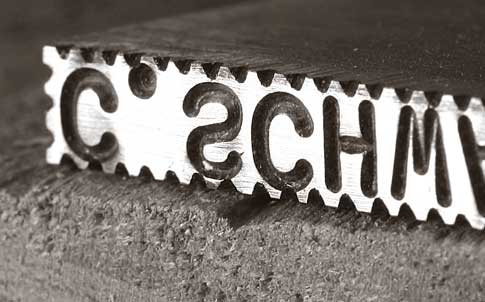
No matter how long you have been working at the craft, you sometimes flirt with the idea that you can buy your way to better craftsmanship.
I first picked up a crosscut saw at age 8, so I should know better than to fall for this false hope. But occasionally as I page through a catalog or look over someone’s tool collection I think: If I only had that Felder/Lie-Nielsen/Ultimatum thingy. Then it would be easy to be fast/skilled/way sexy to other British brace collectors.
And so now you think I’m going to lecture you on how “it’s not the arrows; it’s the Indian,” or that skill is something independent of our personal pile of brass, rosewood and high-carbon steel.
Actually, I’m not.
I’d like to share with you the tool that has improved my craftsmanship every day I’ve owned it for the last nine years. And I expect it to continue doing this astounding feat for another 30 years.
The tool is a maker’s stamp that my wife purchased for me for my 30th birthday from Mazzaglia Tools in Salem, N.H. It’s a simple piece of steel that’s 3/16” thick, 1-1/4” wide and 2-1/2” long. And cut into reverse on one end is “C. SCHWARZ.”

This is always the last tool to touch my work – if it touches it at all. You see, this stamp is the tool that determines if my work is up to snuff. If I won’t sign the piece with this permanent stamp, then I probably need to throw the project on the burn pile (which I’ve done – right after a satisfying hatchet session). Or perhaps I need to go back and remake some assembly or part of the project, try to bring the finish up to a higher level or find some better hardware.
As an added bonus, the project has to be sturdy enough to receive the beating necessary to leave my name in crisp letters. That beating is necessary because the name stamp has the letters incised in the steel block. As a result, you have to hit the stamp very hard with a hammer into the end grain of your project to make it work.
When done correctly, the letters stand proud of a recessed background that is surrounded by a decorative border. Very nice.
I usually pick someplace inconspicuous to apply the stamp, such as the lower edge of a door stile or the bottom of a leg. Then I place the project on the concrete floor of my shop and pinch the stamp between the thumb and forefinger of my left hand. I rest my hammer head on the end of the stamp (which is now mushroomed over from the beatings from my 16 oz. hammer).
I pause for a few moments to make sure I am ready to bring the hammer down in one fell stroke. You get only one change to do it right. It’s just like building a piece of furniture for someone else; there are no do-overs.
I’m just about ready to sign the blanket chest I finished for the next issue of Woodworking Magazine’s summer 2009 issue. But there’s just one little bit of roughness on the chest’s lid. Maybe it needs a little wetsanding first.
If you’d like more information about the stamps from Mazzaglia Tools, write for a brochure: 12 Palmer St., Salem, NH 03079. There are several other companies out there that make fancier stamps as well, such as Engraving Arts and Microstamp.
And if you don’t have the coin for a stamp, you can always use a Sharpie marker to do the same job.
— Christopher Schwarz